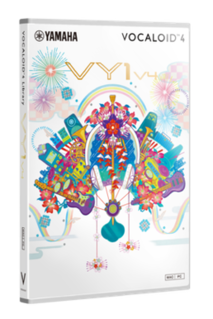
Vocaloid is a singing voice synthesizer software product. Its signal processing part was developed through a joint research project led by Kenmochi Hideki at the Pompeu Fabra University in Barcelona, Spain, in 2000 and was not originally intended to be a full commercial project. Backed by the Yamaha Corporation, it developed the software into the commercial product "Vocaloid" that was released in 2004.

Hatsune Miku, also called Miku Hatsune, and officially code-named CV01, is a Vocaloid software voicebank developed by Crypton Future Media and its official anthropomorphic mascot character, a 16-year-old girl with long, turquoise twintails. Miku's personification has been marketed as a virtual idol, and has performed at live virtual concerts onstage as an animated projection.

Meiko is a humanoid persona for Yamaha Corporation's Vocaloid singing synthesizer application. Her voice is sampled by Meiko Haigō. She has performed at live concerts onstage as an animated projection along with Crypton Future Media's other Vocaloids. She was the fourth Vocaloid ever released and the first to sing in Japanese.

Kaito is a Vocaloid developed by Yamaha Corporation. He has performed at live concerts onstage as an animated projection along with Crypton Future Media's other Vocaloids. His production code name was "Taro". His voice is sampled by Naoto Fūga. He was the fifth ever released Vocaloid and the second in Japanese.

Megurine Luka, codenamed "CV03", is a Vocaloid software developed by Crypton Future Media, headquartered in Sapporo, Japan. Its official moe anthropomorphism is a 20-year-old woman. She uses Yamaha Corporation's Vocaloid 2 and Vocaloid 4 singing synthesizer technology. Her voice is sampled from Yū Asakawa. She has performed alongside other Vocaloids at live concerts onstage as an animated hologram projection.
Crypton Future Media, Inc., or simply Crypton, is a Japanese media company based in Sapporo, Japan. It develops, imports, and sells products for music, such as sound generator software, sampling CDs and DVDs, and sound effect and background music libraries. The company also provides services of online shopping, online community, and mobile content.

PowerFX Systems AB is a small recording company, based in Stockholm, Sweden. The company has been producing music samples, loops and sound effects since 1995. They also developed singing synthesizers using the VOCALOID engine developed by Yamaha Corporation.

Hatsune Miku and Future Stars: Project Mirai is a 2012 rhythm game created by Sega and Crypton Future Media for the Nintendo 3DS. The game is a spin-off of the Hatsune Miku: Project DIVA series of Vocaloid rhythm games and was first released on March 8, 2012 in Japan with no international release. Like the original, the game primarily makes use of Vocaloids, a series of singing synthesizer softwares, and the songs created using them, most notably the virtual-diva Vocaloid Hatsune Miku. It is also the first game in the franchise to include a Vocaloid made by Internet Co., Ltd.; the mascot of Megpoid, Gumi, appears as a guest star.
Vocaloid is a singing voice synthesizer and the first engine released in the Vocaloid series. It was succeeded by Vocaloid 2. This version was made to be able to sing both English and Japanese.

Vocaloid 2 is a singing voice synthesizer and the successor to the Vocaloid voice synthesizer application by Yamaha. Unlike the first engine, Vocaloid 2 based its output on vocal samples, rather than voice analysis. The synthesis engine and the user interface were completely revamped, with Japanese Vocaloids possessing a Japanese interface, as opposed to the previous version, which used English for both versions. It is noteworthy for introducing the popular character Hatsune Miku.

Vocaloid 3 is a singing voice synthesizer and successor to Vocaloid 2 in the Vocaloid series. This version of the software is a much more expansive version, containing many new features, three new languages and many more vocals than past software versions combined.

Vocaloid 4 is a singing voice synthesizer and successor to Vocaloid 3 in the Vocaloid series.

Kagamine Rin & Len, officially code-named CV02, are a pair of Vocaloid software developed by Crypton Future Media, headquartered in Sapporo, Japan. Their official moe anthropomorphism consists of a pair of twin vocals, a boy and a girl both age 14 years old, respectively named Len and Rin. They use Yamaha Corporation's Vocaloid 2 and Vocaloid 4 singing synthesizing technology. Their voices are sampled by Asami Shimoda. They have performed at live concerts together, as they are each other's mirror image.
Sano Takayuki (佐野貴幸), more commonly known as samfree or SAM, was a Japanese music producer heavily involved in composing and arranging songs using Vocaloid software. He was also notably involved in producing theme songs for various anime television series.

Hatsune Miku: Project DIVA X is a 2016 rhythm game featuring the character Hatsune Miku, created by Sega and Crypton Future Media, released on March 24, 2016 for the PlayStation Vita in Japan. A PlayStation 4 version known in Japan as Hatsune Miku: Project DIVA X HD was released on August 25, 2016. A North American and European version has been released for PlayStation 4 and PlayStation Vita on August 30, 2016. The title reflects the game being the 10th entry in the Hatsune Miku: Project DIVA series. The game takes a new approach to play style, focusing around the theme of "Live and Produce".

SF-A2 codename miki is a female Vocaloid character produced by AH-Software Co. Ltd for Vocaloid 2. Her voice is sampled from the Japanese female singer-songwriter, Miki Furukawa.

Sweet Ann is an English Vocaloid developed by PowerFX. Her name is a pun based on her country of origin, meaning that Sweet-Ann = Swe-den. She was released as the first voice for Vocaloid 2. Her voice provider is known only as "Jody" from Australia.

VY1 is a Japanese female vocal developed by Yamaha Corporation and distributed by Bplats, Inc. to act as a "standard" vocal for Vocaloid. It has the codename of "Mizki". It was originally released for the Vocaloid 2 engine.

Yohioloid is an English Vocaloid developed VocaTone and distributed by PowerFX who also has an additional Japanese voice bank. The vocalist sampled for his vocals was Swedish singer Yohio. He was released for Vocaloid 3.
















